by Robin Montgomery Kennedy

I felt the soft grass under my back, a cool breeze across my cheeks. My eyes slowly fluttered open, adjusting to the morning brightness. I began to see patterned varieties of dark gray and white stripes of color, dark to light bands of whites, tans, browns and rusts, revolving. What unique intricate shapes, I thought. I saw soft textures, configurations transforming, designs whirling and changing. What the hell was I seeing? I gasped and jerked onto my elbows and craned my neck back. The spinning abstraction expanded, revealing rust and beige speckles.
I felt a downdraft and snapped into consciousness. I refocused my gaze to just inches above my face, to something whirling, rotating like a ceiling fan. The changing forms were so unfamiliar that I was baffled and scared when, ‘Oh, My God!’ I realized there was a huge bird above my face. I squeezed my eyelids together as tightly as possible and rubbed them to break from the image. My eyes opened to view the full bottom side of a four-foot wingspan circling above my head. It spun and lifted higher and higher, then swooped and glided toward the lake, then flew across the water and out of sight. Shaking, I sat up, grasping what had just happened.
The spot on the grassy bank of Red Haw Lake was my home away from home. It was a place of comfort, a sanctuary with an expanse of green grass that slopes to the water’s reedy edge. The limestone shelter house was perched on a hill a few hundred yards to my left, where I taught yoga twice a week. The redbuds, oaks and maples were budding and leafing out on this spectacular, sunny April day.
Up to that point in my life, I had no notion of what a red-tailed hawk was, much less what one looked like. On the bank that April morning, I had fallen asleep reading Terry Tempest Williams, Refuge: An Unnatural History of Family and Place. After watching the giant raptor disappear into a stand of oaks across the lake, I looked down at the book. On the cover was a picture of the same huge bird that had just scared me. Whoa! I would later come to know it was a red-tailed hawk. Refuge was that week’s assigned reading for the graduate school nature writing class I was taking at Iowa State.
I didn’t pay much attention to animals in the wild when I was younger. The only wild creatures in my home city of Des Moines were the playful brown squirrels in our yard, the ones my mom coaxed to eat peanuts out of her hand. Mom would sit perfectly still on the front steps of our little northside bungalow, barefoot, her polyester shorts bagged out from her thighs just above the knee. Smoke wafted up around the bulbed end of her nose, a lit cigarette in one hand, a whole peanut in the other.
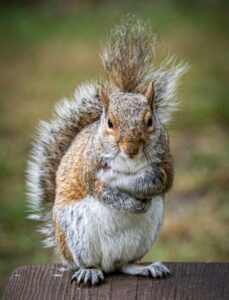
Mom clicked her tongue on the roof of her mouth and sucked in air and made a rapid, “Clque-cluque-clque-clqueoo-clque…” A brown squirrel danced down the bark of the big elm waving its tail from side to side. It scurried up to the steps, and nibbled on the peanut as it lay in the palm of her outstretched hand. Those summer scenes with the squirrels delighted me, because my mom was happy and engaged. We were outside in the sunshine together. I was six years old. Mom was generally not an easygoing, calm person. But with the squirrels, she was patient, a quiet model for me of how to connect with the small wild creatures, of how to be at ease with the unfamiliar and commune with nature.
“You have to sit very still. Hold your palm up and open.” Mom placed a shelled peanut on my hand and whispered, “Shhhh, just wait.” Then she would lure one of our furry friends to the front stoop with her special call, “Clque-coo, clque-coo.” It was difficult for me to hold motionless. My hand started to shake, quivering more as a squirrel ran down the trunk of the tree eyeballing the peanut. It hopped a few feet across the lawn toward us, and stopped with its tail twitching and curled above its back, head turning side to side, and cautiously evaluated the situation.
With a few more jumps across the grass, our hungry little pal was just a foot from my outstretched, trembling palm. My heart pounded and I was shaking all over. “It’s okay,” Mom whispered. “Lower your hand.” The peanut covered most of my palm. I watched the squirrel intently. Its tiny nose vibrated within inches of my fingertips.
“Aaaaahhhhh,” I jumped up. The peanut flew into the air. The squirrel darted back to the elm, sprang up the trunk and disappeared into a mass of green leaves. I bounded up the steps, grabbed the handle on the aluminum screen door, jerked the door open and ran through the porch into the safety of the living room.

I heard Mom yell back, “That squirrel isn’t gonna hurt you.” She laughed. “It’s more scared of you than you are of it.” I never tried to feed the squirrels again, but would sit quietly snuggled up next to Mom under her left arm and watch her do it. The animal would eat from her right hand. Its tiny claws circled round the lower belly of a peanut, with sharp front teeth picking at the top end at rapid speed.
Twenty years later, my husband, our children and I moved to Chariton, a small town in southern Iowa. Red Haw State Park, where the red-tailed hawk surprised me, was a five-minute drive from our house. Marty and I walked in the park every season, even in winter, unless the snow was too deep or it was bitterly cold. Springtime was my favorite, especially after an almost unending Iowa winter. Springtime was the reward for tolerating months of dark, dreary, cloudy, cold days. I felt reborn when the temperature climbed above fifty degrees, the sun emerged, and the wind calmed. “Let’s go, let’s get outside and move,” Marty would encourage me after Sunday breakfast.
He and I often walked in the woods on the five-mile trail that looped around Red Haw Lake. Oaks, maples and elms sheltered the path, providing shade on a hot summer evening and a windbreak in winter. The trail followed the perimeter of the lake at the water’s edge. With its canopy of trees and thick shrubs, the trail provided habitat for varieties of owls, songbirds, catbirds, cardinals, wrens, finches and animals like racoons, skunks, badgers, possums, foxes and more. The shallow water along the edge of the lake teamed with life: frogs, tadpoles, turtles.
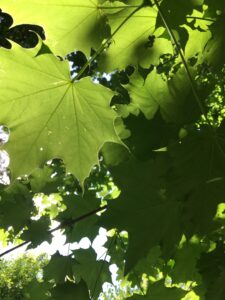
Marty moved slowly, and quietly. He watched and listened, tuned in to bird songs and movements in the underbrush and trees. I learned to stay a step or two behind him and watched the back of his head move and tilt, as he scanned our surroundings. His thick white hair capped his head. It embarrassed him that his hair started to lose color in his late teens. Any trace of auburn was gone by the time he turned forty-five. His head of hair was his signature characteristic. We walked. I chattered. Marty did not make small talk. Calmly he said, “Robin, if we don’t make noise, we may get to see a bird or an animal.”
Marty was the one who encouraged me to get outside and move, to be in nature. We both grew up in the city, but he was an athlete. As a kid he played basketball, baseball, and Ultimate frisbee. He was only five feet ten, but had muscular legs. I remember him flying down the field, spinning and jumping to catch a plastic disc midair with a dozen sweaty guys ready to knock him down. But golf was his favorite. A priest taught Marty the game when he was twelve. Maybe it was through golfing that he learned the benefits of being outside in nature and of intent focus. But he was naturally quiet, and spoke only when he had something to say.
I learned to stroll slowly when we were in nature, and to consciously remember to pick up the pace whenever I walked with someone other than Marty. I was often tired because we had four babies in six years. It was a chore to hike with little kids. One of us often carried a couple of them, or maybe had a baby in a stroller. When the kids grew older, we were able to get out by ourselves for an hour or two, to Red Haw Lake, Pin Oak Marsh, or to the Lake Ellis trail, and caught sight of racoons, deer, an occasional fox, or a badger. On our walks we watched birds, herons, egrets, cormorants, owls, and even migrating pelicans in the spring.
On the trail one morning, Marty heard something and ducked into the underbrush that ringed the lake. I stood motionless, waiting. He stepped back out onto the pathway, made direct eye contact with me and softly whispered, “Shhhhhhhh,” with a finger over his lips. He reached out and grabbed my hand and led me through the bushes to a small clearing on the lake’s edge. His gaze directed mine to the water. Twenty feet from the shoreline, concentric rings expanded and a furry head popped out of the water, its hair slicked back, with a triangle nose tilted up. A river otter grinned playfully in our direction forty yards from shore. It dipped back under the surface and reemerged closer. We watched carefully, standing perfectly still. It seemed delighted to see us, and we were charmed by its water antics.
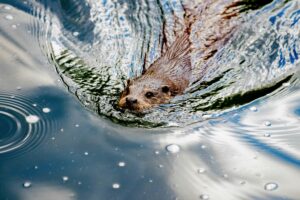
Enchanted by brief sightings of otters, other animals and birds, I also began to walk alone. It felt so good to be outside and moving in nature. I found other trails like the one next to Lake Ellis. I’d walk into the woods and around the marshes to the south of town. I practiced yoga in the big shelter house, or sat on a grassy bank of the lake, the place where the hawk startled me awake. I was not really aware at that point that animals could deliver important messages and offer wisdom.
At the time of the hawk encounter, before falling asleep that day, I was absorbing Williams’ pain in her words. In Refuge, she learns that her mother is dying of cancer. At the same time, in her area, the Great Salt Lake water level began to rise to record heights, threatening the Bear River Migratory Bird Refuge and the hawks, herons, owls, and snowy egrets. A poet and naturalist, she had come to gauge her life by the movements and habits of the lake birds near her home. Williams uses her observations and habits of birds to interweave narratives of dying and accommodation. She and her mother had been exposed to the fallout of atomic bomb tests in the 1950s. Williams grieves, as her mother experiences the trauma of cancer trials then the agony of a radical mastectomy.
I absorbed Williams’ imagery that day on the grass at Red Haw Lake. Her words conjured the loss and memory of my own grandma and mother. I clearly remembered Grandma’s disfigured chest after a mastectomy.
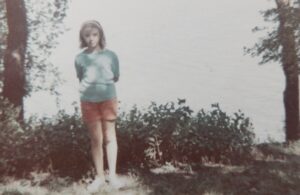
I was just a girl, about ten years old, when I first saw Grandma Tressa standing in front of a full-length mirror with a bare chest. Mom was pinning a pad into the right breast pocket of her bra. “Goddamn it,” Mom swore and sucked the blood from her thumb. She had poked herself because she was always impatient, especially when trying to do anything precise with her hands.
“Ruth, you don’t have to do that. I’m always such a bother,” Grandma told Mom.
“I got it, Mama,” Mom said.
Grandma’s cotton housecoat circled her feet on the floor. I saw her reflection in the mirror, her disfigured chest. It shocked me. I had to look away. “Ugly mess, isn’t it?” Grandma asked me. She must have seen my eyes in the mirror, watched me cringe and turn my back to the sight of the thick shiny scar that covered her upper body on the right side from clavicle to belly. I said nothing, but I could not look again.
Grandma’s bra strap constantly fell out of her dress sleeve, down her shoulder onto mid-arm. She was always slipping the strap back up over her shoulder under her dress. Mom told her to tuck and hide her strap. Grandma, even into her eighties, was a Victorian girl whose modesty about her body prevailed. Mom was trying to help fill the empty bra cup with padding to ease the constant battle to keep her bra up on the vacant side of her chest and to hide grandma’s embarrassment.
In the 1960s and beyond, surgeons took not only breast tissue, but every morsel of adipose down to the muscle of the chest and up into the armpit. Her surgeon removed every bit of fat and lymph nodes, leaving limp skin hanging under Grandma’s arm and thick glossy scars on her right chest wall. I remembered the horror of it, and how I had to subdue my reaction to it. I felt Grandma’s pain and loss move through me, and knew my mom’s pain at having endured the terror of her mama’s cancer and the aftereffects.
The brief hawk encounter spoke to me of the loss of my grandma and of my mother. The hawk’s appearance right above my face, identical to the hawk on the cover of the book lying just next to me on the ground, was more than a coincidence. That red-tail demanded my attention and focus. When I reflected on the significance of the synchronicity, I realized that Williams’ story and my own were intertwined at the moment the red-tailed hawk circled over my face.
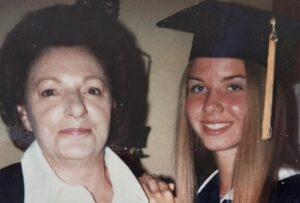
That day at the lake when the red-tailed hawk shocked me into awareness marked the fourth anniversary of my mother’s death. She raised me by herself. My dad died suddenly of a heart attack when I was two. Mom and I lived alone most of the years of my childhood. Grandma came to stay with us once or twice a year. In the summertime, I went to see my aunts and their families for a week or two at a time in rural Iowa. But it was mainly Mom and me. She was my primary support person throughout my childhood.
I was thirty-six years old when Mom passed, and felt that I was too young to lose her. I was communing with Mom in that twilight sleep there at Red Haw Lake, connected in a way I had not been since she died. I felt the hawk was a direct messenger from my mom — maybe it was mom in hawk form. At that point in my life, I was stressed, pushed to the limit, commuting to graduate school across the state, raising four kids and hosting an exchange student. I was exhausted.
I had heard people talk about relatives who had died and come back to visit in the form of birds or animals. My cousin, Doug, said that his dad, my Uncle Merle, had come back as a homing pigeon. Uncle Merle had built a pigeon coop for his sons when they were young, and bought and cared for many pigeons that they raced. It was an intimate hobby that Doug shared with his brother and dad. Right after his dad had died, there had been a pigeon who appeared out of nowhere and sat on the railing of his porch, cocked its head to the side and directly eyeballed Doug.
Initially, I brushed off the story of the pigeon as a way Doug could get attention by telling another tall tale. But eventually, I began to read about the significance and symbolism of animal appearances. Many years later, I read about red-tailed hawks and what they convey to people. I learned that they serve as animals that heighten our spiritual awareness and help us along our paths. According to Native American symbolism, native chiefs always relied upon hawks to protect them through trying times, mostly as messengers of warning. They represent honesty and clear vision. When a hawk appears, it asks you to get in touch with your wild nature. It suggests taking a broader perspective on things. It asks you to step back and not let emotions overwhelm you.
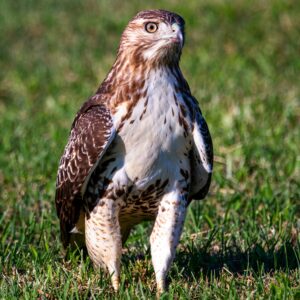
At first, I was overwhelmed, frightened and shocked by the hawk circling just above my face, but it made me curious. I identified the red-tailed hawk by the picture on Williams’ book cover, then started asking other people questions about them. I learned from an outdoorsy friend that they are extremely common birds, often seen circling high in the air. I have not heard of anyone else who has had a hawk circle just inches above their head. The experience made me research the symbolism of the hawk and delve into the different cultures and religions that revere them.
Many Christians believe that a hawk is a symbol of wisdom and vision. This bird helps people see many things that they have never seen before. In Native American symbolism, a hawk sighting is a direct message from the angels and the Great Spirit that the time has come to spread your wings, to fly higher, and to expand your vision. That is a message my mom would have embraced.
I felt alone, tired and stressed the day the hawk appeared to me. My life was complicated with the different roles and challenges I faced. I wondered if I was crazy for pushing myself to handle the intense work of graduate school and the long commute, plus kids and all the household responsibilities. I did all of the marketing, cooking, cleaning, laundry, and errand running and I played the role of emotional support person for our children. Marty was focused on his work and made a decent salary. He supported us financially, but I took care of most of the details on the home front.
The hawk was a clear sign to me, an angel of sorts. I knew the hawk was my mom transported into a tangible, winged messenger. She had come to reassure and encourage me that I was strong and capable. Two of her favorite sayings in trying circumstances were, “This too shall pass,” or, “Things will look better in the morning.” Mom conveyed these things: time and rest often reshape trouble. And remembering her patience with the squirrels reminded me to take time to rest, to play, to be present and to be aware of the small miraculous wonders that appear in front of me each day. Squirrel messengers remind me to balance work and play, to make ready for the future, but to not get lost in the preparations; to find ways to gather and to gift, without giving myself away.
The red-tailed hawk’s main gift to me that day was, “No one ever truly leaves us. There is no death, only transformation.” I can’t define the transformation, but the hawk helped me open my mind and heart to the communication of animals. Guidance comes in miraculous ways when hearts and eyes are fully open. Sometimes animals are the vessels that translate messages from the invisible Source, from the spirits of nature.
Once my mind and heart were opened to animal messages, I discovered a deeper pathway to process my own experiences and emotions. The red-tailed hawk taught me a new world of communication, wisdom and insights, and led me to a tangible, yet mystical route to navigate my way through trauma and grief, to healing.
Copyright © 2025 by Robin Montgomery Kennedy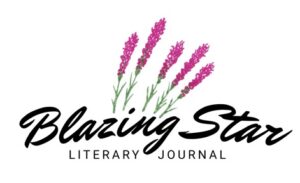
Photographs courtesy of Ruth Montgomery, Russ Mullen, Janine Calsbeek, and Joshua J. Cotten, Andreas Schanti, Ana Paula Grimaldi and Richard Sagredo on Unsplash.
Robin Montgomery Kennedy

Robin Montgomery Kennedy, who holds a master’s in creative nonfiction writing from Iowa State University, writes and teaches writing, public speaking and literature. An outdoor enthusiast, traveler, and explorer with a deep connection to wildlife, she currently works near her home as an Airbnb host and tour guide, leading visitors on hikes into northern New Mexico’s mountains and river valleys.
